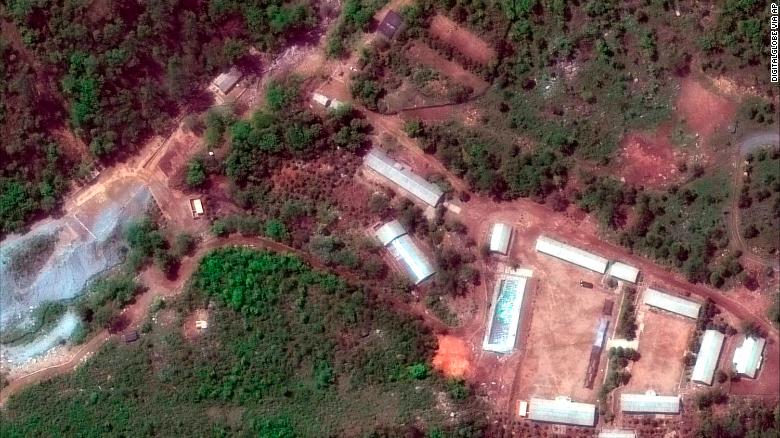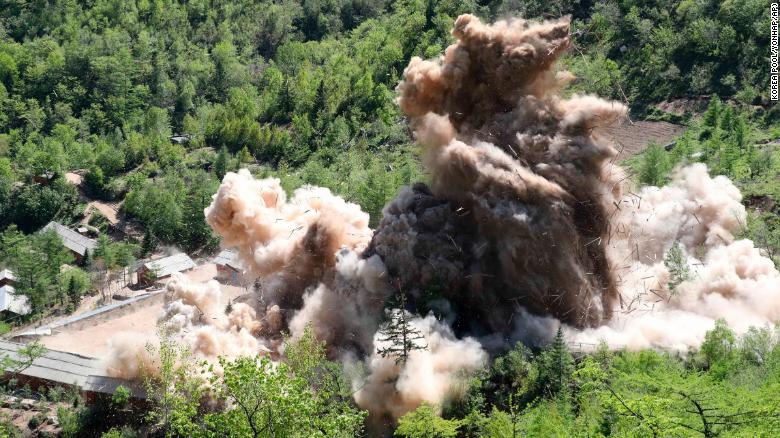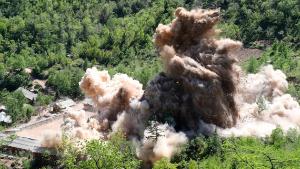North Korea blows up tunnels at Punggye-ri nuclear test site
North Korea appeared to destroy at least three nuclear tunnels, observation buildings, a metal foundry and living quarters at its Punggye-ri nuclear test site on Thursday, in a process observed by invited international journalists.
A CNN crew at the remote mountain site in the country's north witnessed explosions at nuclear tunnels 2, 3 and 4, from observation decks about 500 meters away. They were among two dozen journalists invited into the country to observe the apparent destruction of the site.
Hours later, the White House canceled a planned meeting between North Korean leader Kim Jong Un and US President Donald Trump which had been billed as a historic opportunity to bring peace to the Korean Peninsula.
The move followed days of heightened rhetoric from North Korea -- which had itself threatened to pull out. In a letter addressed to Kim, Trump said: "Based on the tremendous anger and open hostility displayed in your most recent statement, I feel it is inappropriate, at this time, to have this long-planned meeting."
He described the cancellation of the summit as being "for the good of both parties, but to the detriment of the world."
In scathing statements earlier Thursday, Choe Son Hui, a vice-minister in the North Korean Foreign Ministry, had called US Vice President Mike Pence a "political dummy" and warned that North Korea's leadership could reconsider the planned summit.
"Whether the US will meet us at a meeting room or encounter us at nuclear-to-nuclear showdown is entirely dependent upon the decision and behavior of the United States," Choe said.
News of the canceled summit reached journalists on the train as they were still on their way back from Punggye-ri to the North Korean coastal city of Wonsan, an 11-hour journey, prompting a sense of shock.
North Korean officials traveling with them did not give an official comment but immediately got up to make phone calls relaying the news to the top, amid an awkward and uncomfortable atmosphere.
Explosives seen in tunnels
North Korea announced on April 20 that the country had "realized nuclear weaponization," and would no longer need to test nuclear weapons. To demonstrate its commitment, it said it would destroy the nuclear test site.
From Will Ripley in North Korea
The North Koreans took us to three of the four tunnels on the site. They allowed us to open the tunnel doors, take a look inside; we couldn't actually step into the tunnels. As far as the eye could see, they were rigged with explosives.
The North Koreans invited a little more than two dozen of us to witness these explosions. But there were no international experts in this group. There was nobody who could look at the explosions and tell us if they were actually deep enough to destroy the tunnels or if they were simply closing up the entrances.
Imagine how the North Koreans are feeling at the moment, given that they just blew up the nuclear site as a sign, they said, of their willingness to denuclearize and commitment to transparency. They were doing this to make a point ahead of the planned summit.
That said, the North Koreans had said they were not going to beg for dialogue and they were infuriated by comments made by Vice President Mike Pence and before that by Trump's national security adviser, John Bolton, saying North Korea could follow the "Libya model."
Of course, Gadhafi in Libya gave up his nuclear weapons and was overthrown by US-backed rebels and died several years later. They are simply unwilling to accept that here.
North Korea said inviting international media to the event would "ensure transparency of discontinuance of the nuclear test."
The journalists invited to Punggye-ri spent about about nine hours on the ground at the nuclear test site.
No weapons inspectors or nonproliferation experts were invited to witness the event, and it was unclear whether the explosions rendered the tunnels inoperable, or only caused limited damage.
Before the explosions, the journalists said they were invited to look inside three of the four tunnels, which appeared to be rigged with explosives, before moving a safe distance away to witness their detonation.
The amount and type of explosives used were not described by the regime. The CNN journalists present described seeing "soccer ball" sized and shaped explosives, rigged alongside one another, visible for a distance of around 35 meters inside the tunnels.
Officials provided very little technical information and declined to confirm how far the tunnels extended into the mountain.

A May 23 satellite image provided by DigitalGlobe shows the Punggye-ri test site.

A May 24 photo shows an explosion at tunnel 4 of North Korea's nuclear test site.
The journalists watched a succession of explosions, and when they were finished were allowed closer to inspect the damage. Each tunnel was caved in, with rubble blocking the entrance.
From producer Tim Schwarz at Punggye-ri
On the journey from Wonsan, the blinds were drawn on all the windows of the train and we were told weren't allowed to look out.
We got off the train in Jaedokri, in Kilju Country in northern Hamgyong, and drove to the test site, past a number of small villages of maybe a couple of dozen houses. In all of these villages, there was not a single sign of any person, of any ox or goat or chicken or any animal.
The villages were obviously inhabited. It appears that residents were told to keep inside. The fields had been kept neat and tidy. They'd been plowed, there were shoots coming up and they were obviously well-tended.
Normally there would be people working but here was no sign of any inhabitants, not a single person. Along the route, there were six or so military guard points with two guards at each one. They were the only people we saw.
On the way back, I took a closer look and all the blinds on the houses were drawn.
A deputy director of the North Korean nuclear research institute, who refused to give his name, addressed the journalists at the beginning and the end of the day. "The dismantling of the nuclear test ground conducted with a high level of transparency has clearly attested once again to the proactive and peace-loving efforts of the government of the DPRK," he said after the explosions, referring to North Korea.
North Korea has conducted six nuclear tests at the site, which lies more than 200 miles (370 kilometers) north of Pyongyang, the most recent and powerful of which was in September 2017.
Three tunnels destroyed
There are four tunnels at the site, although journalists only witnessed the destruction of three. A fourth tunnel used for one nuclear test in 2006 had already been shut down, North Korean officials said. The other five tests were all carried out in tunnel 2.
Before Thursday's explosions, experts had warned that the tunnels' destruction could destroy valuable evidence of the state of North Korea's weapons program. They told CNN they would want to take samples, as well as radiation counters to assess the levels in the atmosphere.
Journalists who attempted to take radiation measuring equipment into North Korea said it had been confiscated.
Tom Cheshire, a correspondent with Britain's Sky News, said his team's satellite phone and radiation dosimeter -- a device to measure nuclear radiation -- were taken away by security at Wonsan airport. Chinese journalists also had equipment confiscated.
News Courtesy: www.cnn.com











